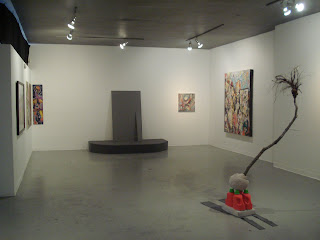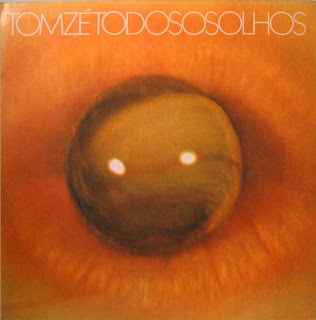
















THE SINISTER URGE
(I would also like to add that I had the pleasure of visiting a park where ten thousand polio victims are buried, and a building where little children were burned alive, and they now haunt said building by putting their tiny little hands against the dirty windows in the basement. Also, I had some terrific Earl Grey tea.)
When I arrived in Kingston to work on Modern Fuel’s 9th annual juried exhibition, I was confronted by a varied group of works by an even more varied group of artists. They were young and old, some established, and others still in art school. It was an expansive spectrum of styles and media, from oil paintings to sculpture and video (a heartbreaking reality was the necessity of an annex exhibition of video art, which we could not include in the main gallery due to lack of space). Some of the works were more “traditional”, while others were experimental in nature, so, I wondered, how could we put a show together that was cohesive and compelling while at the same time honoring the pluralism reflected in the works?
I set out to work out this conundrum in collaboration with Michael Davidge, the director of Modern Fuel, in what turned out to be a combination of aesthetic instinct, an interior designer’s eye, curatorial experience and gut instinct in order to pick works for the exhibition.
If there is a modus operandi or discernible strategy in the way the works were picked, it is this: We decided to abandon the traditional curatorial focus on thematic, media or generational specifity in favor of finding the uncanny relationships between disparately different works of art. Like the backward-talking dwarf in David Lynch’s Twin Peaks, It was our objective to put together a show were the strange and the familiar coalesce into a slightly unsettling whole.
Faced with such a great variety of works, we abandoned a cohesive dialectic based on the media or thematic message as described above, and focused instead on creating lateral connections between the pieces in order to take the viewer on an oddball romp through the multi-faceted artistic landscape of the region. The works were arranged so that their relationships create a contrapuntal rhythm that is the central theme of the exhibition. Much like the characters in Twin Peaks (or Barbara Streisand’s nose), many of the works evince an offbeat allure that appeals to my sensibility as a curator. Some of the works are eccentric, others more conventional, but they are always filled with the self-assurance that comes with having nothing to prove, and rebelling in their own abandon. The contrast between the two extremes of the conventional and non-conventional is what ultimately makes the show work for me. Like a corpse buried in the flowerbed, there is a sinister quality to the concoction, and I was very fortunate that Michael and I shared the same sensibility with regards to this approach.
On the subject of creating a cohesiveness based on bold aesthetic relationships regardless of the degree of technical “virtuosity” demonstrated in the individual works, I am reminded of a story told by (I think) Brice Marden, in which a curator friend, while visiting the artist’s studio, was asked to help out in selecting the works for Marden’s new show (it seems the artist was having a considerable degree of difficulty in getting the show to “gel”) so the curator pointed at one of the most accomplished works in the grouping and said, “take out that painting over there”. And then, pointing at one of the rejected paintings leaning against a wall, he said: “put this one where the other one used to be,” and suddenly the whole show came to life.
This is what Michael and I were going after: Not to look for stars, but to find a great ensemble cast. Thus James Greatrex’s grey wooden video platform became one of the central foci of the exhibition; this despite the fact that the artist decided to enter it in the show as a joke. But the hulking grey form, in relation with the other works of art, became the equivalent of the black monolith in 2001:A Space Odyssey. We put the monolith on a plinth that consisted of a platform that was already in the space and matched the grey of the wooden form, lending the object a totemic quality so that Greatrex’s grey monolith, like a priest at the ancient temple of the Cult of Minimalism, activates and presides over the space. Next to the monolith is Michelle Larose’s small, beautifully rendered modernist “vase” painting, and it in turn is placed next to Jeremy Mulder’s expressionistic large canvas, with its violent line and texture and it’s “Sodom and Gomorrah comes to Kingston” motif. And suddenly, an overarching contextual framework begins to emerge, characterized by chaos, working in conjunction (and opposition) with order. If Apollo with his methodical orderliness, and Dionysius with his offhanded messiness, where to duke it out in an Olympian version of Dueling Banjos this is what the result of their battle would look like. Like a visual distillation of Donnie and Marie Osmond’s “I’m little bit country, and I’m a little bit rock and roll”, The collective presence of the works in the exhibition takes on the character of a house of cards. Remove one of the pieces, and the whole thing falls apart.
By way of example, I would like to mention a small sampling of the works in the show:
Lisa Figge’s disturbing “Big Mouth” video is another totemic presence in the gallery space. In the video, the artist’s giant lips, projected on the wall at the entrance of the gallery, spew out accusations in a creepy whisper, floating and disembodied in a bluish pallor. It is a sickly Cerberus guarding the gates of hell. Her sculpture of a decrepit palm tree coming out of a carved granite coconut that is precariously balanced on empty laundry detergent bottles that emanate from a carved stone “island” on a sea of dirty grey carpet strips dominates the center of the gallery space.
Maayke Schurer’s Let’s Play House, a video in the aforementioned video art “salon”, was shot entirely at a landfill site. The protagonists of the video are the discarded dolls and toys and scavenging birds as they sing to the soundtrack of a sappy R n’ B track from a mixed tape that was also found at the landfill.
Elisa Paloschi (a photographer who is known for her gorgeous travel shots) offers a murky, creepy landscape. Reminiscent of a nightmare, the photo, shot in Italy’s beautiful Tuscany region, reminds me of the work of Andres Serrano; particularly his Piss Christ. Evil also lurks behind the surface in Irina Skvortsova’s portrait of two women (one of whom is the artist herself) as they regard each other with bedroom eyes. Although the painting appears unfinished, the figures have been exquisitely rendered, in soft hues and sensuous line. But upon close examination one becomes aware of a series of violent lines in the underpainting that are almost ripping through the figures. This is contrasted by Miriam Netten’s painting of a goat. Painted in a highly keyed color scheme with blues and pinks and glitter glue, the goat is reminiscent of the work of a child. But the painting is deceptively simple. There is an overallness and a compositional sophistication to the work that makes it integral to the balance of the show.
The hanging of the works was designed to create a flow within the exhibition space, while at the same time propelling the overarching thematic concept. But where is this concept? It lies in the interaction between the viewer and the gallery space, as if the show itself were an installation piece designed to engulf the viewer and elicit a response. And if the works could be said to have something in common, it would be that all of them are compelling and cause the viewer to react either with pleasure, curiosity or extreme repulsion. If this occurred at all, then our objective was reached. As William Peter Blatty said in reference to his (and William Friedkin’s) film The Exorcist, “Whether you loved it or hated it, at least you knew that during those two hours you were truly alive.”




